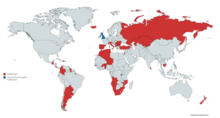Closed list
Closed list describes the variant of party-list proportional representation where voters can (effectively) only vote for political parties as a whole, and thus have no influence on the party-supplied order in which party candidates are elected. If voters have at least some influence, then it is called an open list.
| Part of the Politics series |
| Electoral systems |
|---|
|
Plurality/majoritarian
|
|
|
Other systems and related theory |
|
|

In closed list systems, each political party has pre-decided who will receive the seats allocated to that party in the elections, so that the candidates positioned highest on this list tend to always get a seat in the parliament while the candidates positioned very low on the closed list will not.
However, the candidates "at the water mark" of a given party are in the position of either losing or winning their seat depending on the number of votes the party gets. "The water mark" is the number of seats a specific party can be expected to achieve. The number of seats that the party wins, combined with the candidates' positions on the party's list, will then determine whether a particular candidate will get a seat.
List of locations with closed list proportional representation
- Albania
- Algeria
- Andorra
- Angola
- Argentina
- Armenia
- Benin
- Bulgaria
- Burkina Faso
- Burundi
- Cambodia
- Colombia (depending on the party)
- Costa Rica
- Dominican Republic[1]
- East Timor
- Equatorial Guinea
- Guatemala
- Guinea-Bissau
- Guyana
- Hong Kong
- Iceland
- Israel
- Italy
- Kazakhstan
- Kyrgyzstan
- Moldova
- Montenegro
- Morocco
- Mozambique
- Namibia[2]
- New Zealand[3][4]
- Nicaragua
- Niger
- North Macedonia
- Paraguay
- Portugal
- Romania[5]
- Russia
- Rwanda
- Serbia
- South Africa
- Spain
- Sri Lanka
- Taiwan
- Togo
- Tunisia
- Turkey
- Uruguay
See also
- Open list
- Ley de Lemas
- List of democracy and elections-related topics
References
- "{title}". Archived (PDF) from the original on 2015-11-22. Retrieved 2018-09-02.
- "Elections - GRN Portal". www.ecn.na. Archived from the original on 2018-07-21. Retrieved 2018-07-20.
- In New Zealand, there is open list and closed list voting
- "New Zealand country brief". Department of Foreign Affairs and Trade. Retrieved 15 July 2019.
- Filimon, Paul (20 July 2015). "Legea ALEGERILOR PARLAMENTARE pe LISTE, promulgată de Iohannis". România Liberă (in Romanian). Archived from the original on 2017-07-02. Retrieved 2018-05-24.
External links
- Country profiles at IFES
- Open, Closed and Free Lists at Ace Project